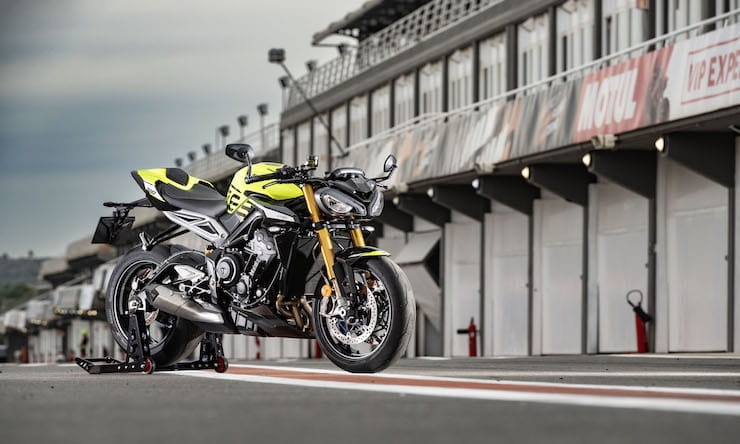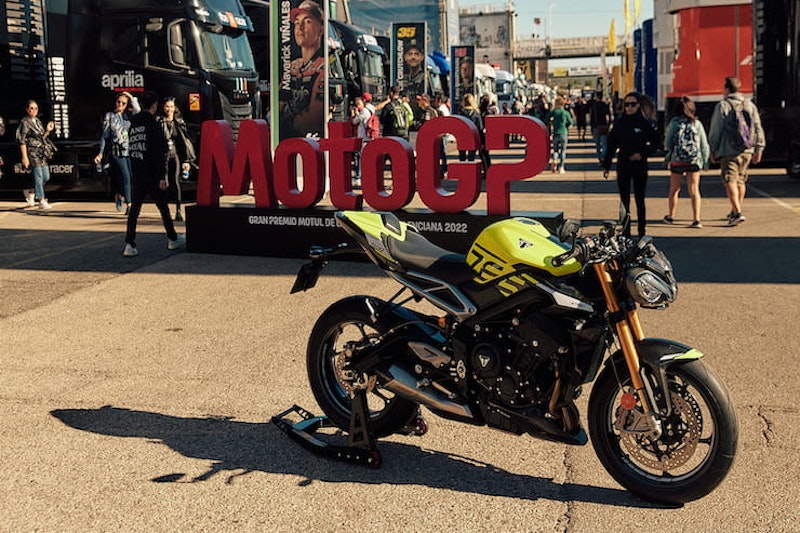Win on Sunday, sell on Monday
It’s a well-worn adage you’ve likely come across before to broadly explain why manufacturers go racing and, simplistic though it may be, it’s fundamentally accurate. Though it should be pointed out motorcycles can also be bought on a Tuesday through to Saturday as well…
Competing in motorsport can be a gamble though. Win and the rewards are yours to reap. Lose and it might be a quiet day in the showroom on Monday.
Simply turning up demands a price to be paid (literally), but it’s an investment - be it time, money, effort, blood, sweat, tears and working on the weekend - that can also offer a return of the highest value.
Triumph can relate to this notion of risk versus reward… but not because it has its eyes on a podium-topping prize like fellow Grand Prix paddock dwellers Ducati, Honda, Yamaha et al.
That’s because it’s presently in the midst of a second term as exclusive engine supplier to Moto2, a responsibility it assumed from Honda in 2019.
The unit of choice is the triple-cylinder 765cc block developed for the Street Triple naked, extending a link between what you and I can experience on the road to the honed, stripped back grand prix beasts being flung around on track.
Top of the line (aka. pricey) sportsbikes and plus-ton cc’d motorcycles are invariably pushed front and centre of campaigns basking in the glow of on-track success. But for Triumph, its Moto2 project instead synergises with its popular and affordable mid-range Triumph Street Triple 765, an endorsement that brings prestigious and practical benefits.
It’s an association Triumph is eager to emphasise with the new generation 2023MY Street Triple, so much so it chose to reveal it to the media at the MotoGP/Moto2/Moto3 season finale in Valencia, enlisted Randy Mamola to throw some shapes aboard it on track and - more excitingly - pulled the wraps off a loud flu-ro liveried limited edition Moto2 variant to celebrate its GP partnership.
While not a sportsbike in the ‘traditional’ sense, the Street Triple 765 is a “sports-bike”, with the increase in power for the 130PS RS version contributing to Triumph’s claim of ‘class-leading performance’
Indeed, sporty though the Street Triple RS is, it is something of an alien when placed alongside the shrink-wrapped prototype race bikes of Moto2 to the extent it’s hard to believe they share anything in common.
And yet Triumph adamantly - and very proudly - maintains the engine that powers its Street Triple differs less from what powers a Moto2 bike than you might think. Translated, the Moto2-spec unit gets increased bore and stroke, a different crank, pistons and connecting rods, plus a revised gearbox, which combined allows for more power and higher revs.
If seeing is not believing, then the distinctive thrum of a Triumph three-pot engine is unmistakable… not least with the volume turned up to 11 by an orchestra of 30 revvy Moto2 ‘instruments’ harmonising on the grid.
Four years of high praise for Triumph’s 765 engine from riders, teams and Dorna testifies to it being, well, a triumph not just for Moto2 as a race series, but for the British marque itself.
In essence, Moto2 acts as an invaluable test platform for the engine, both in terms of performance and durability, while adding a little Grand Prix sparkle to the brand sheen.
With engineers set the challenge of stretching the standard engine’s peak power output from 123PS to the 140PS stipulated for Moto2, Triumph has the opportunity to study how components fare within the extremities of racing conditions multiplied by upwards of 30 bikes at any one time.
It’s an education that has not only enabled Triumph to extract an increased 145PS for Moto2 next season, it is mirrored by the latest generation Street Triple RS getting 130 ponies to play with too.
“When we developed the previous version of this engine it was right at the start of the Moto2 project and at that point in time we were pushing the engineers hard to ask, ‘what do you think you can get out of the 765 engine?’,” Chief Product Officer, Steve Sargent tells BikeSocial.
“In terms of the [123PS] road bike, when we went into Moto2 we said we wanted to push that performance envelope further and really show what we can do. In Moto2 we are in a situation where you are rebuilding engines every three races, so you can to some extent push the performance further but it also allows you to capture a lot of data in terms of what happens to this engine when you really push it.”
While some purists might be tempted to call out the firm for swerving away from pitching itself into direct open combat with rivals, even if winning isn’t the primary objective of this particular racing project, it doesn’t mean there is nothing to lose for Triumph if it can’t deliver.
After all, generating bad publicity from a problematic and unreliable engine in a multi-manufacturer series is one thing. To remain as reliable as possible across dozens of bikes on a global platform is another entirely…
With a modus operandi to place the onus on rider performance and skill by standardising other critical factors - the tyres, the engine, various components - Moto2 strives for mechanical parity to theoretically allow the best of tomorrow’s generation to shine.
Then again, while this is partly an attempt to rip the ‘dodgy bike’ chapters from a disgruntled riders’ ‘book of excuses’, equal status doesn’t spare Triumph from the responsibility of striking the right balance between performance and durability.
After all, who needs a rider F-bombing your brand during heated, adrenaline-pumped interviews because a technical issue forced them out of a race?
It’s therefore in Triumph’s interests to adopt the ‘to finish first, first you have to finish’ mantra, but it’s a balance riders are emphatic has been successfully struck, opining confidence that the engine’s durability and power allows them to focus on the actual racing.
Full throttle development
This esteemed positive feedback is complemented by the practical benefits of Triumph’s substantial Moto2 investment.
In fact, Triumph can lay claim to possibly the biggest and best engine development team of any manufacturer as it collects reams of data from each rider completing each lap in each full throttle session at 20 characteristically different venues.
“What you have to remember is that in Moto2 you have 30 riders that are desperate to get to MotoGP, so if anyone on this planet can ride a Street Triple 765 to its absolute limits it’s going to be them,” Sargent continues.
In four years, Triumph has supplied 257 engines to ExternPro, the engineering firm enlisted to prepare, maintain and rebuild the units to ensure parity once they are distributed to the Moto2 teams.
With a constant rotation of around 120 engines, each is used for 12 races and will undergo three rebuilds during that time before being decommissioned.
According to Trevor Morris, Technical Director of ExternPro, this year’s season finale in Valencia saw total engine mileage since 2019 reach the magic 1,000,000km mark. That’s roughly the equivalent of riding around the world 25 times…
In 2022 alone, more than 9000 laps were completed across the 20 races, equating to around 45,000km total. With tens of thousands more kilometres covered in practice, qualifying and private testing sessions too, it provides Triumph with an invaluable source of data.
While common sense precludes the notion of anyone riding a Street Triple 765 RS in the manner of a Moto2 bike (not legally, anyway…) or expect an engine rebuild every few months, it is nevertheless a chance for Triumph to understand which components stand up to stress, an insight that trickles down towards ensuring your Triumph doesn’t wear and tear itself apart prematurely.
“As for what we get out of it, when we get a rebuild they get stripped back and we get to see what’s happening inside of the engine.
“When we strip one of these engines down and open them up, they are absolutely immaculate. The good thing about that is, when we go back to the engineers and ask ‘can we push the road bike a little bit further’?
“From all of the data we have seen in Moto2 where we rev the bike to 14,000rpm (compared with the 12,650rpm RS) we can see that we have durability and reliability, so we can afford to push it a little bit further.”
It’s this immensely rigorous test of engineering quality that Triumph is keen to harness in its promotional message that the Street Triple 765 really is the closest thing to riding a Grand Prix motorcycle on the road.
So while you may not be Jake Dixon, Sam Lowes or Pedro Acosta, the connection between a Moto2 rider claiming victory on Sunday is closer than you might expect to the customer claiming the keys to a brand-new Triumph Street Triple on Monday.
Or any other day of the week, for that matter..
Share on social media:

